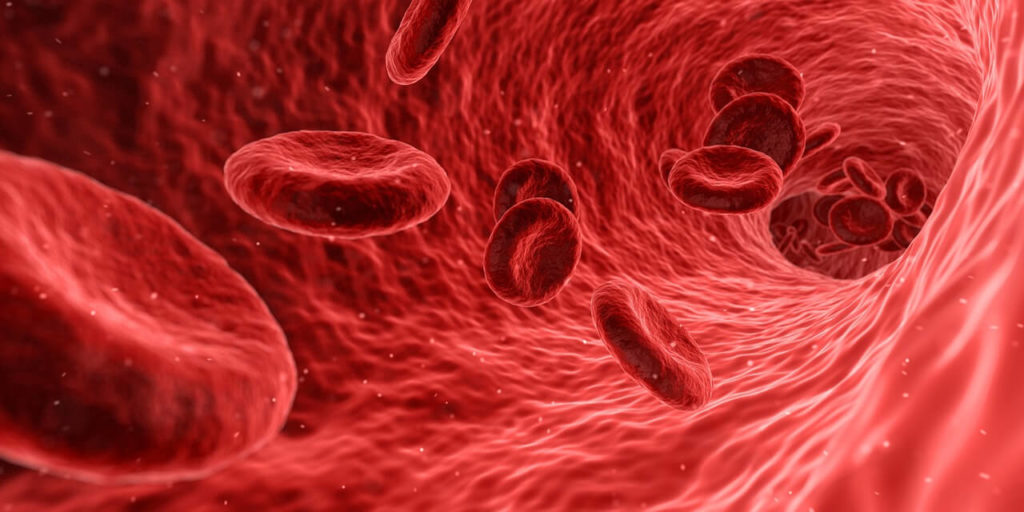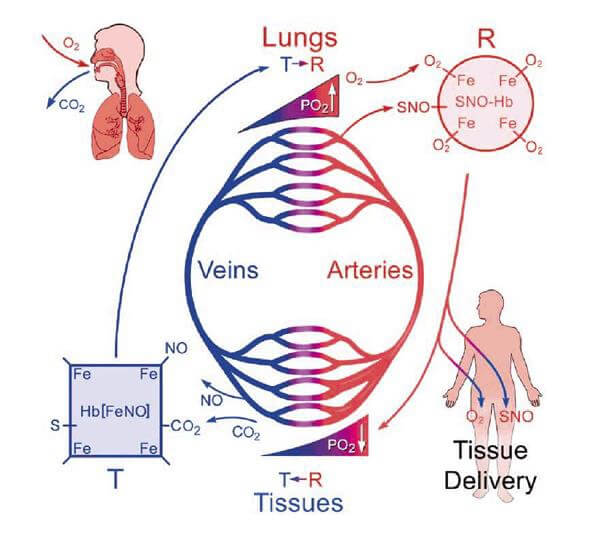Oxygen and Nitric Oxide – You Can’t Have One Without the Other

Oxygen is the life-giving element that is essential for life on Earth.
If you don’t believe this statement, try holding your breath for several minutes. The air we breathe in the atmosphere is 21% oxygen. We exhale 16% oxygen so the body only uses about 5% of the oxygen we breathe in. That’s why we can deliver oxygen to others in crisis by taking our exhaled air and providing mouth to mouth respiration.
What happens to that oxygen we breathe in is very complicated and requires many different processes in order for that oxygen to be converted into cellular energy so that every cell in the body can do its job.
So, let’s go through that process since if there is disruption at any level, the body cannot perform and chronic disease, including cancer, begins.
What Happens to the Oxygen We Breathe in?
With each breath, the lungs take the oxygen to the deepest and smallest part of the lungs, the alveoli. It is here that the alveoli have direct contact with the blood. Oxygen diffuses into the blood and binds to hemoglobin in our red blood cells.
This is also where carbon dioxide is released from the blood into the lung airways and excreted with each breath.
This is called the cardiorespiratory cycle. Now that oxygenated blood goes directly to the heart where it is pumped out to the rest of the body.
This process requires at least 2 important processes.
One is that oxygen must reach all parts of the lungs. Second, every part of the lung must have sufficient blood supply in order for gas exchange to occur. This is the earliest step where things can go wrong.
Firstly, if we are at high altitude where the partial pressure of oxygen is less, then with each breath, we take in less oxygen because there is less of a pressure gradient to force oxygen into the lungs. This is why some people develop altitude sickness when they go to higher elevations. If our lungs sense low oxygen, called hypoxia, then our body shuts down blood supply to those regions of the lungs that sense low oxygen.
This is what is referred to as a mismatch in ventilation to perfusion. This is a protective mechanism that try to shunt blood supply to regions of the lungs where there is adequate oxygen to absorb.
The problem is that if this is not corrected, the poorly perfused regions of the lungs are susceptible to infections and over time, fluid will fill the lungs further interfering with oxygenation and further restricting blood supply so our immune system cannot fight off the infection.
This entire process is dependent upon proper oxygen delivery to the lungs.
Hopefully you can understand now the enormous benefits of deep breathing so we maximize oxygen delivery to all parts of the lungs.
Now for the Complex Biochemistry…
Assuming we have efficient oxygen uptake in the lungs and sufficient saturation of our blood cells with oxygen, this oxygen now has to be delivered to every cell in the body.
This is where really complex biochemistry occurs.
 Arterial blood coming from the heart is fully oxygenated and bright red. As the blood goes through the capillaries, the smallest blood vessels in the body in direct contact with every cell in the body, the hemoglobin in our red blood cells changes its shape as it senses lower oxygen as it goes from the arteries to the veins.
Arterial blood coming from the heart is fully oxygenated and bright red. As the blood goes through the capillaries, the smallest blood vessels in the body in direct contact with every cell in the body, the hemoglobin in our red blood cells changes its shape as it senses lower oxygen as it goes from the arteries to the veins.
It is this change in structure (from Relaxed (R) to a tense (T) state) that allows oxygen to come off and to be delivered to every cell in the body. This change in shape allows for the hemoglobin to bind carbon dioxide and take it back to the lungs where it is excreted and picks up more oxygen.
This process occurs with every breath we take throughout out entire lives.
“Without oxygen, we cannot make nitric oxide. Without nitric oxide, we cannot deliver oxygen.”
Recent scientific discoveries reveal that nitric oxide is required in order for hemoglobin to deliver oxygen. Without nitric oxide, the hemoglobin protein cannot change its structure and therefore cannot deliver oxygen.
What does this mean? It means that the body becomes oxygen deficient and the body cannot make energy. Blood oxygen levels drop, respiration rate increases and our bodies become acidic.
This has especially been obvious during COVID. The primary issue with any respiratory virus is the loss of oxygen saturation in the blood. We’ve seen in COVID patients that get really sick and their oxygen saturation drops, they go to the hospital and put on supplemental oxygen and their oxygen levels fail to improve.
This is because their bodies cannot make nitric oxide to improve oxygen saturation and delivery. This is a vicious cycle because we need oxygen to make nitric oxide in the lining of our blood vessels.
Without oxygen, we cannot make nitric oxide. Without nitric oxide, we cannot deliver oxygen. Do you see the problem?
What Happens Without Sufficient Nitric Oxide?
The next step is to get the oxygen into the mitochondria, the parts of the cell that actually convert the oxygen into energy (ATP). Nitric oxide inside the cell increases the efficiency of oxygen conversion to cellular energy.
Without sufficient nitric oxide, this process creates a lot of “oxidative stress” and formation of toxic oxygen radicals.
This inefficient oxygen metabolism can lead to chronic fatigue syndrome, low pH, low oxygen and fermentation inside the cell. It is this process that was described by Otto Warburg back in the early 1900s that leads to the development of cancer.
If this does not get your attention, then nothing will.
Loss of nitric oxide explains everything we know about the onset and progression of all chronic diseases, including cancer.
If we need oxygen to make nitric oxide and we need nitric oxide to deliver oxygen, how do we solve this riddle? What came first, the chicken or the egg?
What if Your Body Doesn’t Make Enough Nitric Oxide?
That is the power of my nitric oxide technology. If your body cannot make nitric oxide, then we do it for you.
Once we introduce nitric oxide gas into the body, you improve perfusion of the lungs which means better oxygen uptake. The nitric oxide binds to hemoglobin and ensures adequate delivery of oxygen to every cell in the body.
Now the enzyme nitric oxide synthase found in all blood vessels in the body has the oxygen it needs to produce nitric oxide. The nitric oxide found inside the cells can now improve the efficiency of oxygen conversion to cellular energy (ATP) we decrease oxidative stress and all cells can now perform their duties.
When this happens, every organ, tissue and cell in the body works better.
A proper analogy is sometimes when our car battery is dead, all we need is a jumpstart with jumper cable. Our cellular batteries sometimes need a jump start to get things working again. That is the job of nitric oxide.
We need oxygen. We need nitric oxide. You cannot have one without the other. Our lives depend on it. Get your nitric oxide jumpstart today. Your body will thank you for it.
Every day take a few moments throughout the day and take 10 deep breathes through the nose and out through the mouth. Do this at least 3 different times throughout the day. Take in that life giving oxygen to help support every biological function in the body.
